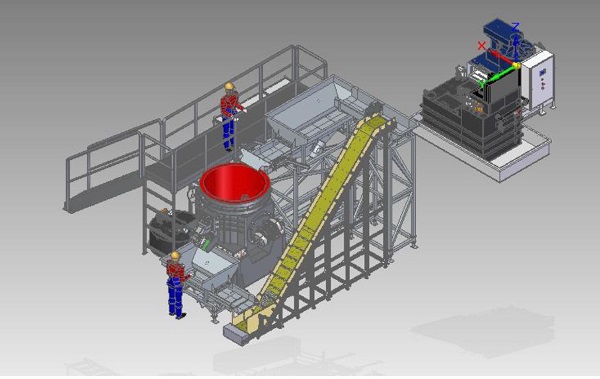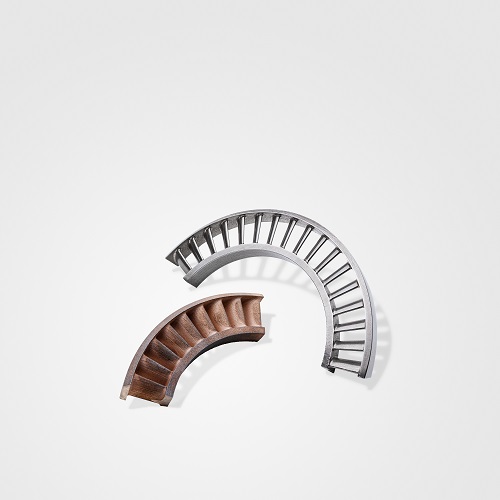
At the Surface Technology exhibition Walther Trowal introduces the MV 50 multivib vibratory finishing machine for the fully automatic surface finishing of large components for aircraft turbines like blisks, but also for forging dies. With an internal diameter of 1,650 mm the MV 50 is the largest machine of its kind ever built by the company.
The first of this new generation of mass finishing machines will be used for finishing blisks (“blade integrated disks”) for aircraft turbines. To a considerable extent the quality of the surface finish on these components determines, how well they are performing under operational loads. A good surface finish allows the turbulence-free airflow through the integrated blades. This helps decrease the fuel consumption and noise emissions and optimizes the overall efficiency
The company who purchased the first MV 50 finishing machine chose the mass finishing technology, because blisks require an extremely smooth surface, but with the sharp edges of the blade segments remaining intact.
With a usable diameter of 1,300 mm the MV 50 can also handle planetary gears for wind turbines, where the finishing of internal surface areas is especially critical. Likewise, it can also be used for large forging dies, which, to date, could not be treated in a mass finishing machine.
The new finishing system was designed for fully automatic operation. Once the work piece has been mounted into the bottom of the processing bowl, no additional manual operations are required. Compared to previous finishing methods this improves the process consistency and stability. Moreover, the new finishing system saves time, because on average the finishing process requires cycle times of less than three hours.
Christoph Cruse, sales director at Walther Trowal, is focusing on the special quality requirements of the aerospace industry: "Especiallye is attached to a special work piece holder outside of the machine and is then placed into the processing bowl of the MV 50 by crane. Subsequently the work piece holder with attached work piece is placed on an adapter plate in the processing bowl, where it is magnetically clamped.
In the next step the bowl is automatically filled with processing media. Specially placed vibratory motors induce a vibration into the processing bowl. This causes the media to flow over all surface areas of the work piece. Since this is firmly attached to the processing bowl, the contact between media and work piece is particularly intensive, but at the same time extremely gentle. External as well as internal surface areas are subject to the same processing intensity. This results in a highly homogeneous finish of the entire work piece surface. On average surface roughness readings of Ra = 0.2 to 0.4 µm can be achieved.

Upon completion of the finishing process the unload gate in the processing bowl is opened discharging the media onto a conveyor belt. This transports the media into a storage hopper, from where it is returned into the processing bowl for the next finishing cycle. Any residual media is removed from the finished work piece with a pneumatically movable rinsing nozzle.
Since the aerospace industry demands an extremely high process consistency with repeatable results, the media in the storage hopper is weighed and, if required, new media is automatically added. This is a very critical part of the process, because over time the media wears and becomes smaller. This could result in a lower fill level in the vibratory finishing machine and would result in deteriorating results. The media replenishment system ensures that the process remains consistent. At the same time it minimizes the need for manual operations. in the production of components for aircraft turbines any manual manufacturing operations can be detrimental because they can be highly inconsistent. With the new automated machine we are eliminating the risk for human error. Moreover, the finishing time per blisk is reduced from several days to a few hours.”
For finishing the surface of blisks Walther Trowal is using the processing media AF. This media generates extremely low surface roughness readings on the materials typically used for the manufacture of blisks. The first MV 50 machine will be delivered to an aerospace customer by September this year.
At the Surface Technology exhibition Walther Trowal will display the smaller sibling of the MV 50, namely, the MV 25 that can handle work pieces with a diameter of up to 600 mm and that is utilizing the same “multivib” technology.
Walther Trowal at the Surface Technology 2022 exhibition
June 21 – 23, 2022 in Stuttgart/Germany
Hall 1, Booth C16
Technical background
One work piece at a time is attached to a special work piece holder outside of the machine and is then placed into the processing bowl of the MV 50 by crane. Subsequently the work piece holder with attached work piece is placed on an adapter plate in the processing bowl, where it is magnetically clamped.
In the next step the bowl is automatically filled with processing media. Specially placed vibratory motors induce a vibration into the processing bowl. This causes the media to flow over all surface areas of the work piece. Since this is firmly attached to the processing bowl, the contact between media and work piece is particularly intensive, but at the same time extremely gentle. External as well as internal surface areas are subject to the same processing intensity. This results in a highly homogeneous finish of the entire work piece surface. On average surface roughness readings of Ra = 0.2 to 0.4 µm can be achieved.
Upon completion of the finishing process the unload gate in the processing bowl is opened discharging the media onto a conveyor belt. This transports the media into a storage hopper, from where it is returned into the processing bowl for the next finishing cycle. Any residual media is removed from the finished work piece with a pneumatically movable rinsing nozzle.
Since the aerospace industry demands an extremely high process consistency with repeatable results, the media in the storage hopper is weighed and, if required, new media is automatically added. This is a very critical part of the process, because over time the media wears and becomes smaller. This could result in a lower fill level in the vibratory finishing machine and would result in deteriorating results. The media replenishment system ensures that the process remains consistent. At the same time it minimizes the need for manual operations.














